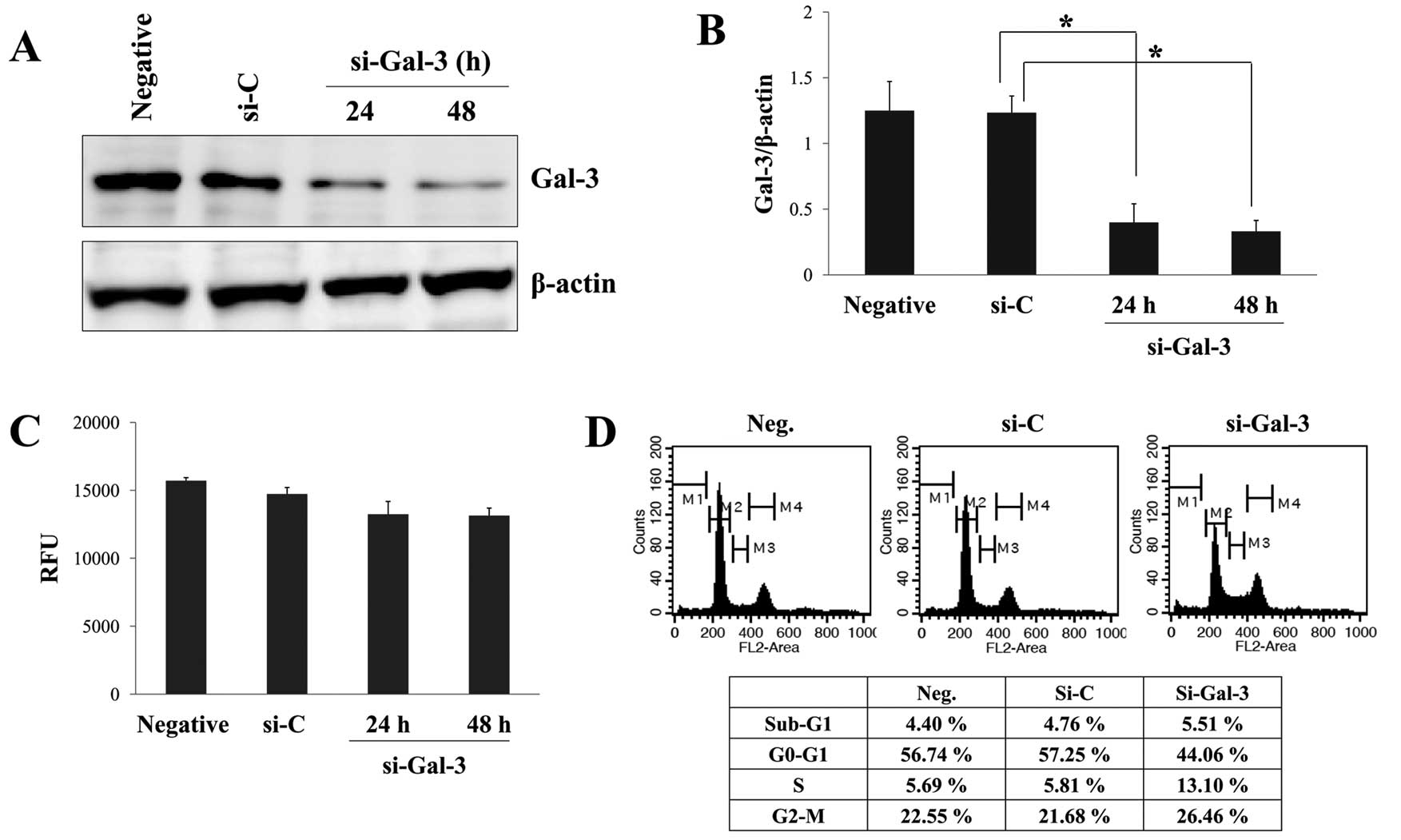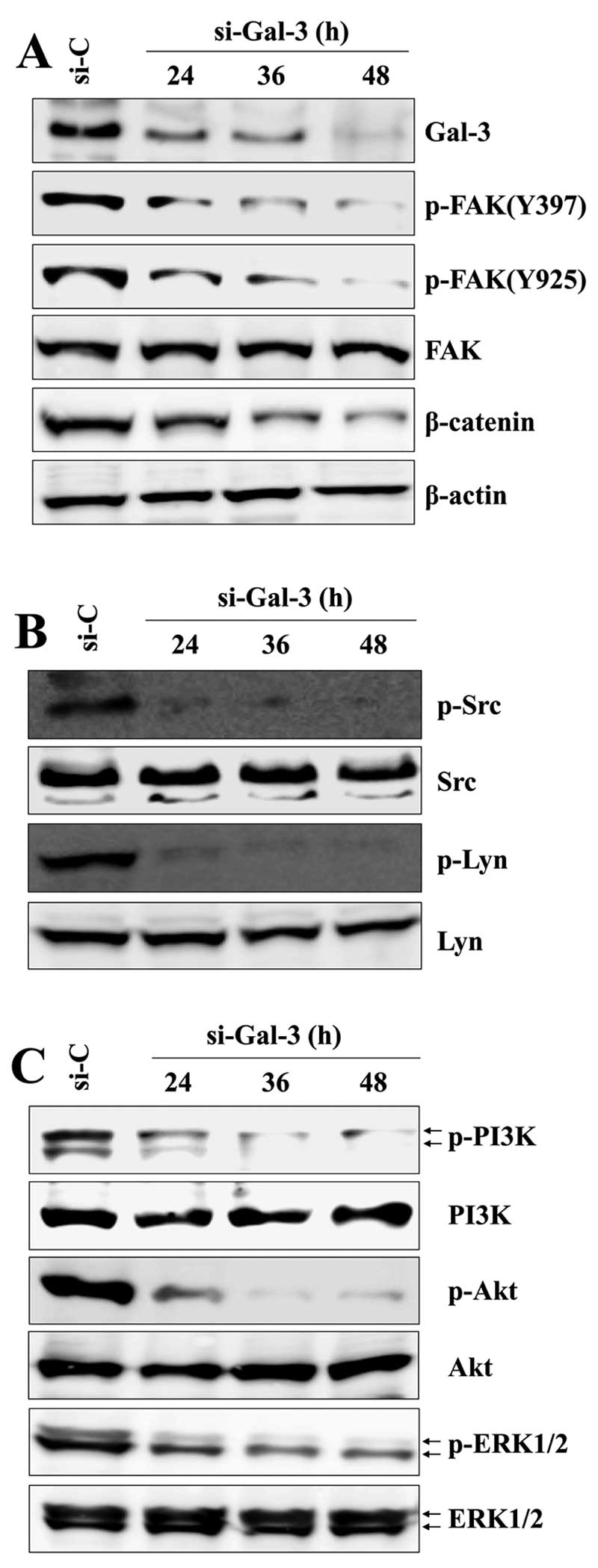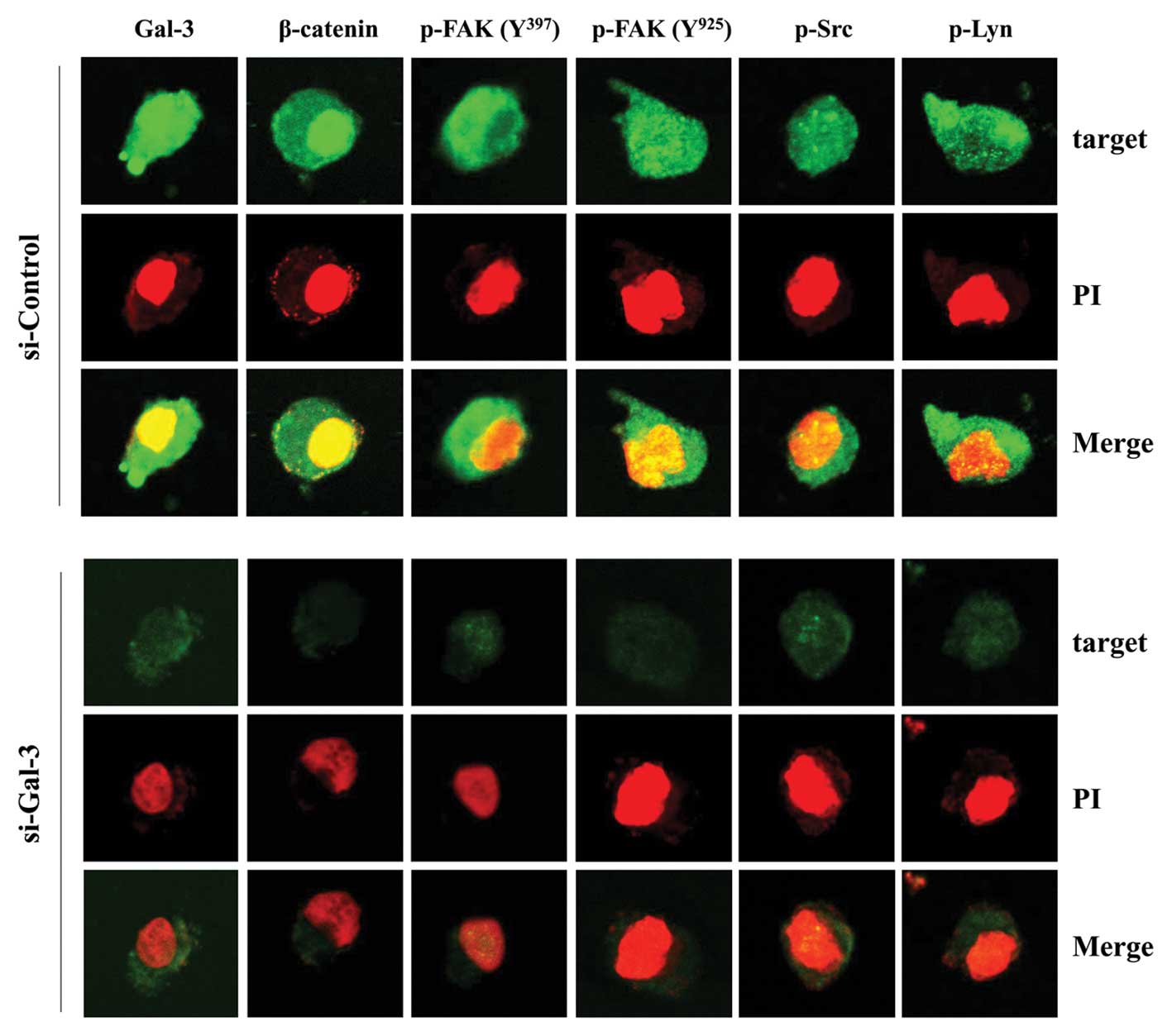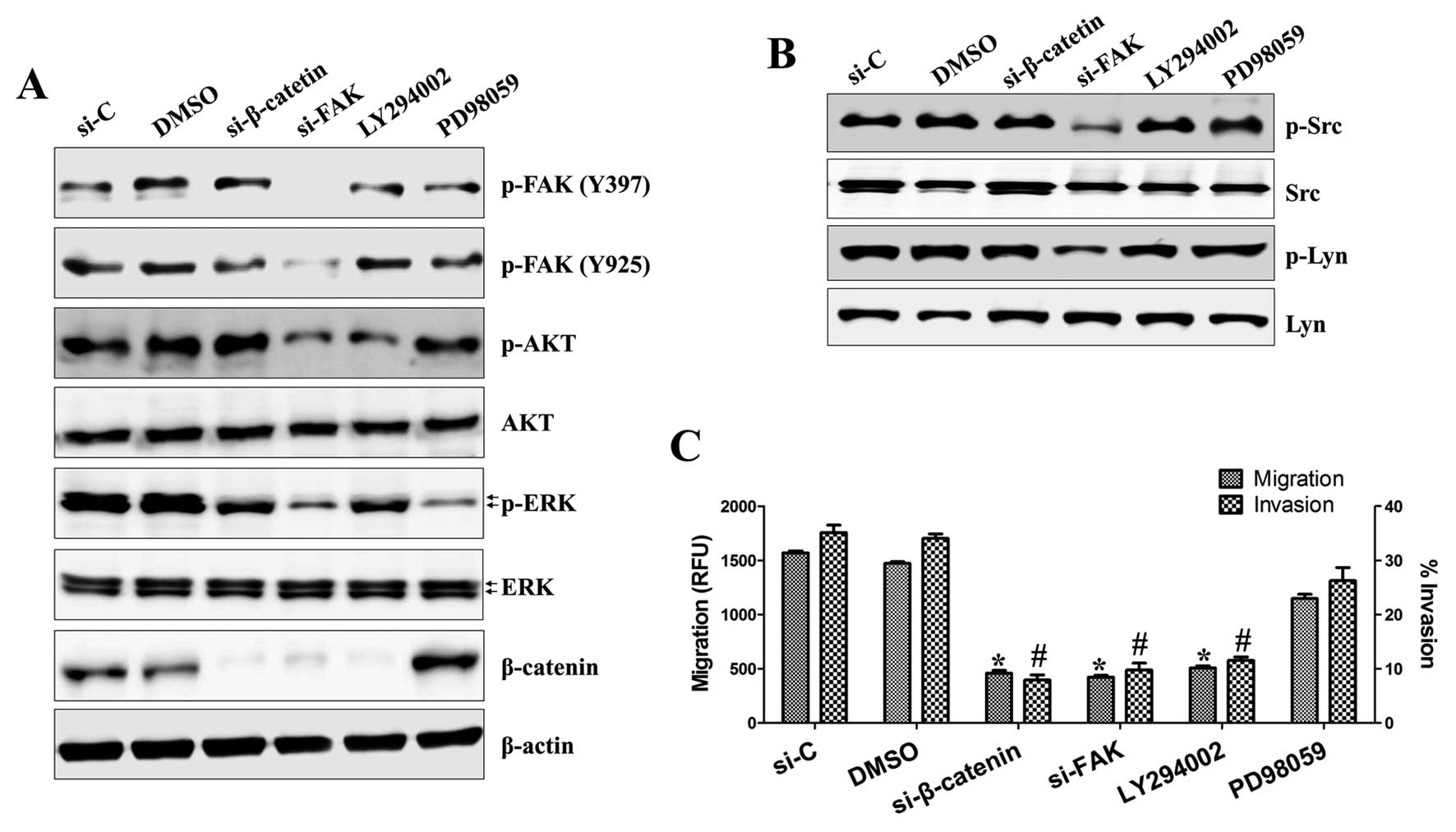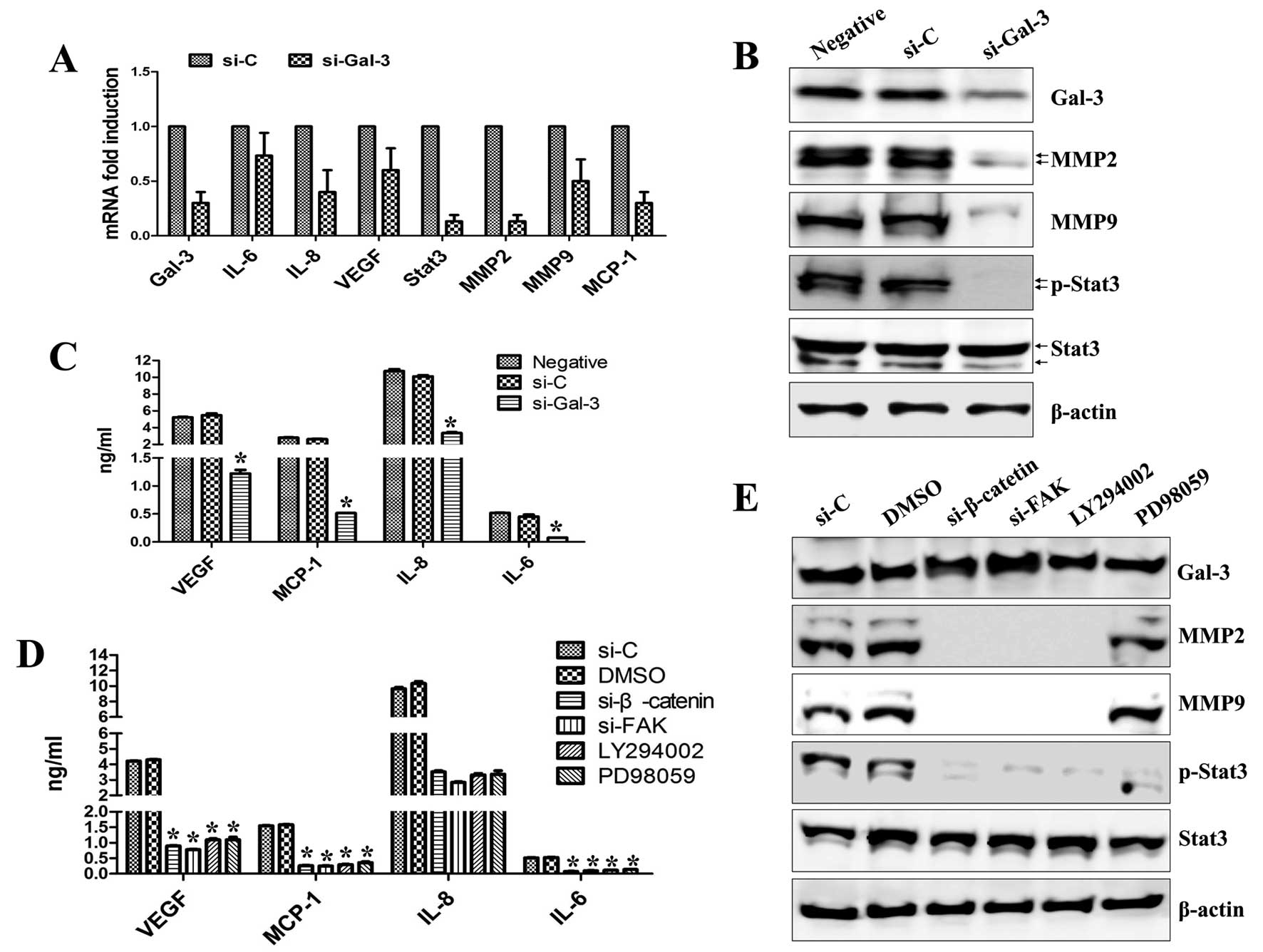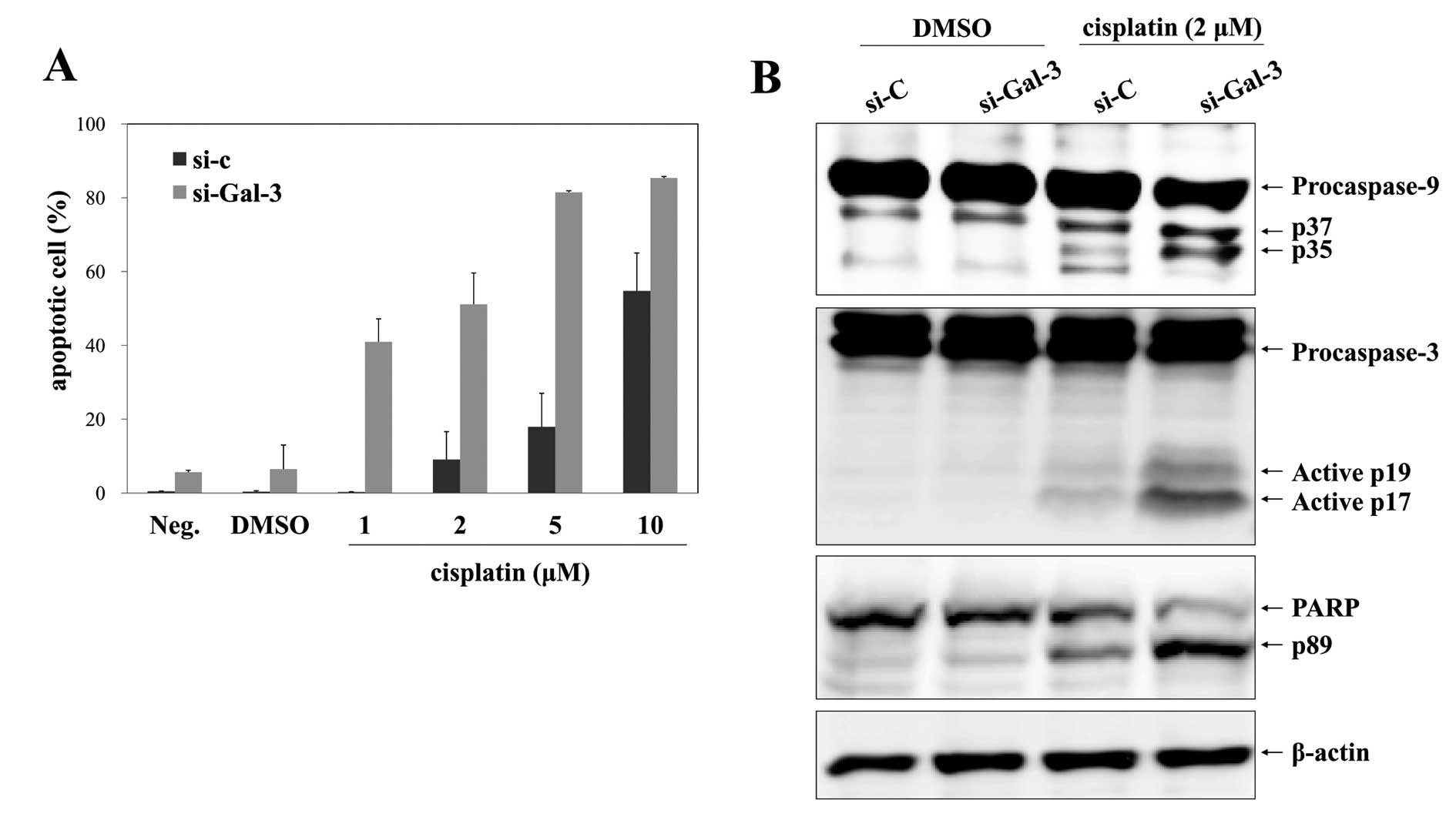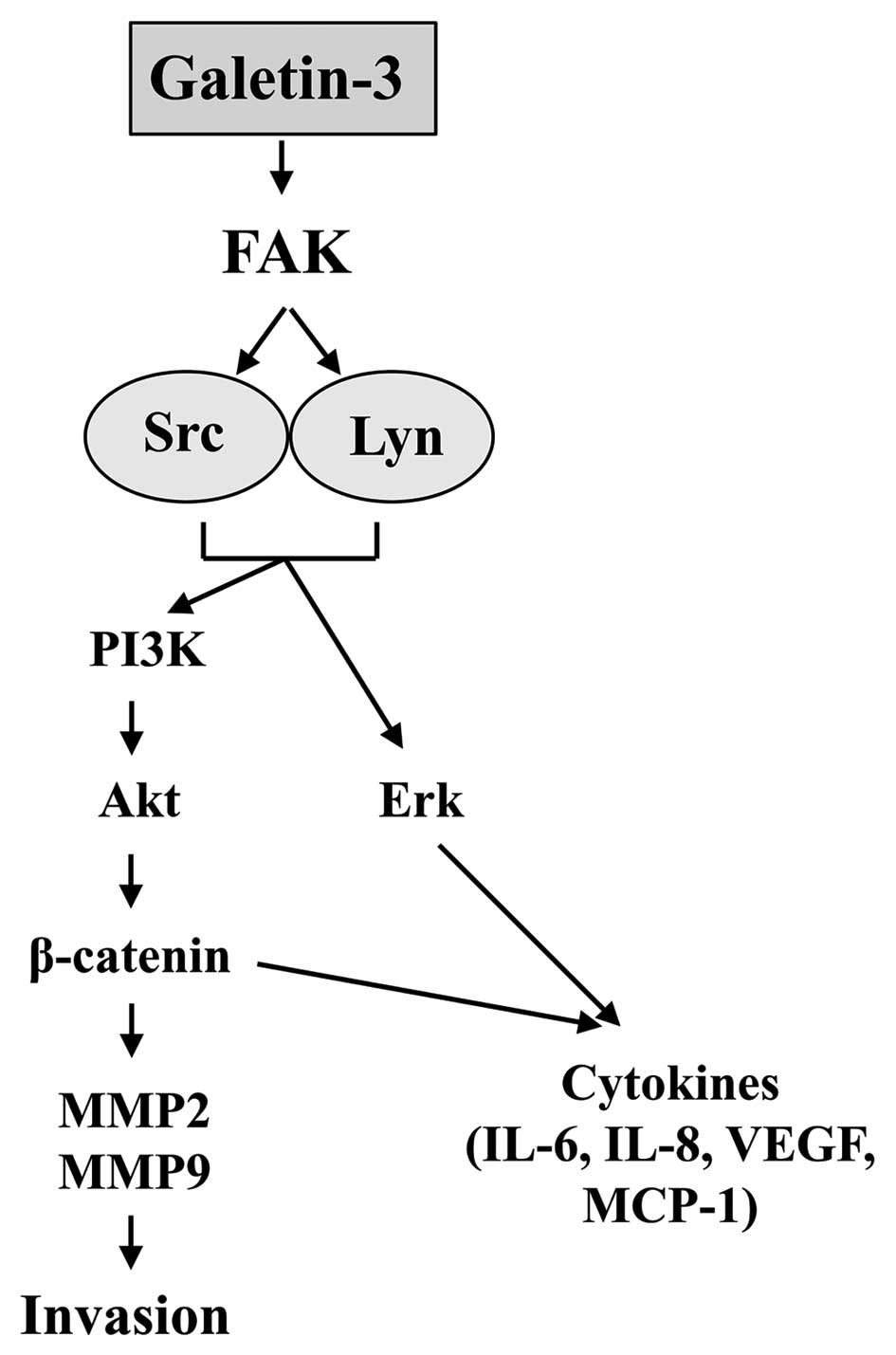Silencing of galectin-3 represses osteosarcoma cell migration and invasion through inhibition of FAK/Src/Lyn activation and β-catenin expression and increases susceptibility to chemotherapeutic agents
- Authors:
- Published online on: October 22, 2014 https://doi.org/10.3892/ijo.2014.2721
- Pages: 185-194
Abstract
Introduction
Galectin-3 (Gal-3) is a chimera-type member of the carbohydrate-binding protein family with high affinity for β-galactosides (1). Gal-3 is located in the nucleus, cytosol, mitochondria, cell surface and extracellular space and is also secreted. Gal-3 has been shown to be involved in extracellular interactions between the cell surface and extracellular matrix glycoproteins and glycolipids, and intracellular interactions between nuclear and cytoplasmic proteins to regulate signaling pathways (2). Gal-3 contributes to various cellular processes, including cell growth, malignant transformation, metastasis, angiogenesis, adhesion, migration and drug resistance (3,4). Gal-3 expression in pancreatic cancer and gastric cancer cells increases cell migration and invasion (5,6). Gal-3 in breast cancer cells greatly enhances adhesion to endothelial cells (7). Overexpression of Gal-3 through the introduction of Gal-3 cDNA increases proliferation of oral tongue squamous cell carcinoma (TSCC) cells and induces invasion and epithelial-to-mesenchymal transition (EMT) (8). Gal-3 also promotes β-catenin/Wnt signaling and induces cyclin D1 and c-Myc in TSCC and breast cancer cells (8,9).
β-catenin is a multi-functional protein that plays a key role at adherent junctions and in Wnt signaling, and deregulation of β-catenin is associated with the development of various human malignancies (10). Binding of canonical Wnts to frizzled (Fz) receptor and low-density lipoprotein 5 or 6 (LRP5/6) co-receptors leads to inhibition of β-catenin phosphorylation and subsequent translocation into the nucleus and activates the expression of Wnt-responsive genes (11). Wnt signaling increases osteoprogenitor cell proliferation and prevents apoptosis (12,13). Based on gene expression profiling of human osteosarcoma, deregulated Wnt signaling is also involved in high metastatic rate and poor long-term survival (14).
Osteosarcoma (OS) is the most extensive malignant bone tumor, occurring primarily in children and adolescents and accounting for ~35% of all cases of bone cancer and the survival rate of OS patients with localized disease is ~65% (15). However, despite significant progress in OS treatment in recent years, because of the high rate of metastasis and relapse and the poor response to combination chemotherapy and radiation therapy, this disease has a poor prognosis and the survival rate of patients with metastasis is ~25% (16). Despite aggressive chemotherapeutic treatment strategies, metastatic lesions develop rapidly and the molecular mechanisms that are involved in osteosarcoma growth and metastasis are not fully understood.
EMT is a major phenotype of cancer metastasis and invasion. Wnt/β-catenin and focal adhesion signaling pathways (FAK, Src and paxillin) cooperatively regulate the overall process of EMT (17). Mechanical loading on osteocyte also activates the β-catenin signaling pathway by a mechanism involving nitric oxide, focal adhesion kinase and the Akt signaling pathway (18). Increased β-catenin-mediated activity has been frequently reported in osteosarcoma (19,20). However, the correlation between Gal-3 and β-catenin signaling in OS remained unclear. In the present study, we provide the first demonstration that Gal-3 is implicated in the regulation of migration and invasion of OS cells subjected to expression of β-catenin. We also focus on discovering the molecular mechanism underlying OS metastasis.
Materials and methods
Cell culture
The human OS cell line HOS was purchased from the American Type Culture Collection (ATCC, Manassas, VA, USA). Cells were maintained in RPMI-1640 medium (HyClone, Logan, UT, USA) supplemented with 10% fetal bovine serum (FBS; HyClone) and antibiotics under a humidified atmosphere with 5% CO2.
Chemicals
Cisplatin (Sigma-Aldrich, St. Louis, MO, USA) was dissolved in sterile dimethyl sulfoxide (DMSO). PD98059 was purchased from Calbiochem (San Diego, CA, USA). LY294002 was purchased from Cell Signaling Technology (Beverly, MA, USA).
Transfection with small interfering RNA (siRNA)
Experimentally verified human Gal-3-siRNA duplex, FAK-siRNA duplex, and negative control-siRNA were obtained from Bioneer Corp. (Daejeon, Korea) and siRNA targeting human β-catenin was purchased from Santa Cruz Biotechnology (Santa Cruz, CA, USA). Cells were transiently transfected by electroporation under optimized conditions. Briefly, cells were electroporated with 300 nM siRNA in serum-free medium in a 0.4-cm electroporation cuvette using the Bio-Rad Gene Pulser Xcell System (Bio-Rad Laboratories, Hercules, CA, USA).
Cell proliferation assay
Cell proliferation was measured using the AlamarBlue assay. After 24-h transfection, cells were plated in triplicate in 96-well plates at a density of 5×103 cells/well. After incubation for 24 h, AlamarBlue (Serotec Ltd., Kidlington, Oxford, UK) was added (10% by volume) to each well and relative fluorescence was determined 9 h later using a SpectraMax M2e Multi-Detection Microplate Reader (Molecular Devices, Sunnyvale, CA, USA; excitation, 530 nm; emission, 590 nm). Relative fluorescence unit (RFU) values were expressed as mean ± standard deviation (SD) of three determinations.
Migration and invasion assay
EBV-infected HCECs transendothelial migration assay was performed using CytoSelect™ tumor transendothelial migration assay kit (Cell Biolabs, Inc., San Diego, CA, USA), according to the manufacturer’s protocol. Migrated cells were measured the fluorescence (RFU) by microplate reader. The invasion assay was determined using the CultreCoat 96 Well Medium BME Cell Invasion Assay kit (R&D Systems, Minneapolis, MN, USA), according to the manufacturer’s protocol. Invaded cells were stained with calcein AM and quantified by microplate reader.
Wound healing assay
Wound healing assays were used to measure the migration ability of bone cancer cells. Transfected HOS cells were plated in 6-well plates. After the cell layers had reached confluence, we inflicted a uniform wound in a straight line in each monolayer using a 200-μl micropipette tip and washed the plates with PBS to remove all cell debris. The cells were cultured in 5% CO2 at 37°C and images were taken at 0 and 48 h after scratching using an inverted phase contrast microscope at ×100 magnification.
ELISA
Concentrations of IL-6 and IL-8 in the culture supernatants were quantified using a single cytokine ELISA kit (Single Analyte ELISArray; Qiagen, Hilden, Germany). VEGF and Gal-3 were quantified using a single cytokine ELISA assay kit from R&D Systems. The data are expressed as the average of biological replicates ± SD.
Analysis of apoptosis and cell cycle by flow cytometry
The percentage of human HOS cells undergoing apoptosis was determined by flow cytometry using FITC-labeled Annexin V (BD Biosciences, San Diego, CA, USA) and 7-amino-acti-nomycin D (7-AAD; BD Biosciences). After transfection for 24 h, cells were treated with 1, 2, 5 or 10 μM cisplatin for 24 h and then harvested, rinsed with PBS, and incubated with Annexin V and 7-AAD in Annexin V binding buffer at room temperature for 15 min in the dark. For cell cycle analysis, cells were harvested after 36-h transfection, washed twice with PBS (2% FBS), fixed with 70% cold aqueous ethanol, and stored at 4°C for at least 1 h. Cell pellets were stained with staining solution containing RNase A (10 mg/ml) and propidium iodide (PI; 2 mg/ml) in PBS for 30 min in the dark at room temperature. The percentage of apoptotic cells and the DNA content were measured using a FACSCalibur flow cytometer (BD Biosciences) equipped with the CellQuest Pro software (BD Biosciences).
Real-time PCR
Total RNA was extracted using an RNeasy Mini kit (Qiagen) according to the manufacturer’s protocol and transcribed into cDNA using oligo(dT) (Bioneer) and reverse transcriptase (Bioneer). mRNA levels were quantified using an ECO Real-Time PCR system (Illumina, Inc., San Diego, CA, USA) and a SYBR-Green Master Mix kit (Takara, Tokyo, Japan) with the following specific primer sets: Gal-3 (upstream primer, 5′-CCA AAG AGG GAA TGA TGT TGC C and downstream primer, 5′-TGA TTG TAC TGC AAC AAG TGA GC); IL-6 (upstream primer, 5′-GTG TTG CCT GCT GCC TTC CCT G and downstream primer, 5′-CTC TAG GTA TAC CTC AAA CTC CAA); IL-8 (upstream primer, 5′-ATG ACT TCC AAG CTG GCC GTG GCT and downstream primer, 5′-TCT CAG CCC TCT TCA AAA ACT TCT C); VEGF (upstream primer, 5′-AGG AGG GCA GAA TCA TCA CG and downstream primer, 5′-CAA GGC CCA CAG GGA TTT TCT); MMP2 (upstream primer, 5′-TGG CAA GTA CGG CTT CTG TC and downstream primer, 5′-TTC TTG TCG CGG TCG TAG TC); MMP9 (upstream primer, 5′-TGC GCT ACC ACC TCG AAC TT and downstream primer, 5′-GAT GCC ATT GAC GTC GTC CT); STAT3 (upstream primer, 5′-ACC TGC AGC AAT ACC ATT GAC and downstream primer, 5′-AAG GTG AGG GAC TCA AAC TGC). A specific primer set for β-actin (upstream primer, 5′-ATC CAC GAA ACT ACC TTC AA and downstream primer, 5′-ATC CAC ACG GAG TAC TTG C) was used as a control. The relative amount of mRNA was calculated using the arithmetic formula 2−ΔΔ Cq, where ΔCq is the difference between the threshold cycle of a given target cDNA and an endogenous reference cDNA.
Immunoblotting
Cells were washed in PBS and lysed in NP-40 buffer (Elpis Biotech, Daejeon, Korea) supplemented with a protease inhibitor cocktail (Sigma-Aldrich). To address phosphorylation events, an additional set of phosphatase inhibitors (Cocktail II; Sigma-Aldrich) was added to the NP-40 buffer. Protein concentration was determined using a BCA assay kit (Pierce, Rockford, IL, USA). Proteins (10 μg/sample) were resolved by SDS-PAGE and transferred to nitrocellulose (Millipore Corp., Billerica, MA, USA). The membranes were blocked with 5% skim milk and standard western blot analysis was performed. Chemiluminescence was detected using an ECL kit (Advansta Corp., Menlo Park, CA, USA) and the multiple Gel DOC system (Fujifilm). Primary antibodies (Abs) against the following proteins were used: MMP2, MMP9, caspase-3, caspase-9, PARP, β-actin, phospho-FAK (Tyr397), phospho-FAK (Tyr925), FAK, phospho-Src (Tyr416), Src, phospho-Lyn (Tyr507), Lyn, phospho-Stat3 (Tyr705), Stat3, phospho-PI3K p85 (Tyr458), PI3K p85, phospho-Akt (Ser473), and Akt (Cell Signaling Technology); Gal-3 and VEGF (Santa Cruz Biotechnology). Data were analyzed using ImageJ 1.38 software.
Confocal microscopy
Cells were permeabilized with permeabilization buffer (0.1% saponin in PBS) and incubated with primary Ab against Gal-3, β-catenin, phospho-Src, phospho-Lyn and phospho-FAK for 30 min on ice, followed by incubation with FITC-conjugated secondary Ab for 20 min. The nucleus was stained with PI (BD Biosciences) for 10 min. Cells were mounted in a Dako fluorescent mounting medium and observed by confocal laser scanning microscope (Carl Zeiss) at ×400 magnification. Images were acquired using confocal microscopy software release 3.0 (510META; Carl Zeiss).
Statistical analysis
Data were expressed as mean ± standard deviation (SD). Statistical analysis was conducted using one-way analysis of the variance (ANOVA). P-values <0.05 were considered statistically significant.
Results
Effect of Gal-3 silencing on proliferation and cell cycle distribution of human osteosarcoma cells
Many previous studies have implied that Gal-3 is involved in growth, angiogenesis, migration and invasion in various cancers (3,4). To determine the potential role of Gal-3 in OS progression, we inhibited Gal-3 expression in the HOS cell line using a siRNA system, which is a powerful tool for investigating gene function. We first confirmed that HOS cells expressed high levels of Gal-3 by RT-PCR (data not shown) and western blot analysis (Fig. 1A) analyses. Significant inhibition of Gal-3 expression at the protein level was detected 24 and 48 h after transient silencing of Gal-3 with specific Gal-3-siRNA, whereas control-siRNA had little effect on Gal-3 expression and there was no noticeable difference between untreated control cells and control-siRNA transfected cells (Fig. 1A and B). At 48 h after transfection, protein levels of Gal-3 were reduced by ~77% in cells transfected with Gal-3-siRNA. We examined whether Gal-3-siRNA affected proliferation and cell cycle distribution of HOS cells. Contrary to our expectations, there was no significant difference in proliferation between cells transfected with Gal-3-siRNA or control-siRNA (Fig. 1C). Although treatment with Gal-3-siRNA slightly affected cell cycle distribution, Gal-3 silencing did not cause great changes in the distribution compared with control-siRNA (Fig. 1D). These data suggested that Gal-3 silencing does not block the proliferation of HOS cells completely but slightly contributes to the growth and cell cycle.
Gal-3 silencing suppresses migration and invasion of osteosarcoma cells
In addition to proliferation, increased migration and invasion are crucial features defining cancer progression and inhibition of these functions may be a possible target for anticancer therapy. Gal-3 expression in pancreatic cancer and gastric cancer cells increase cell migration and invasion (5,6). We therefore characterized the role of Gal-3 in the migration and invasion of OS cells. Wound healing and migration assays were performed to examine the effect of Gal-3 silencing on cell motility. The time required for wound closure in HOS cells with silenced Gal-3 was significantly longer than that required for corresponding control cells (Fig. 2A), suggesting the involvement of Gal-3 in cell migration. As shown in Fig. 2B, Transwell migration assays showed that the migration capacity was reduced ~3.5-fold in Gal-3-siRNA transfected cells compared with the control-siRNA group (Gal-3-siRNA, 479±60 RFU; control-siRNA, 1.701±56 RFU). Furthermore, we found that Gal-3 silencing also suppressed invasiveness of the HOS cells; cell invasion was decreased ~4-fold in Gal-3-silenced cells compared with control-siRNA cells (Gal-3-siRNA, 9.027±0.466%; control-siRNA, 36.324±0.719%). These results indicate that Gal-3 mainly regulates OS cell migration and invasion at least in vitro in our experimental systems.
Gal-3 silencing decreases β-catenin expression and suppresses activation of FAK/Src/Lyn and Akt/ERK
Next, we investigated the molecular mechanism by which Gal-3 mediates the motility of HOS cells. Recent studies have shown that Gal-3 is closely associated with β-catenin/Wnt signaling in several tumor types (8,9). The PI3K/Akt and ERK1/2 pathways are key signaling pathways involved in the migratory behavior or invasiveness of various tumors (21). ERK1/2 controls cytoskeletal reorganization and focal adhesion turnover through the activation of specific cytoskeletal and focal adhesion proteins, such as FAK and paxillin (22). First, we investigated the potential signaling molecules underlying Gal-3-mediated β-catenin expression, focusing on FAK and Src family tyrosine kinases (SFKs). Gal-3 silencing markedly reduced β-catenin expression and the phosphorylation of FAK at Y397 and Y925 residues in a time-dependent manner (Fig. 3A) and decreased phosphorylation of Src and Lyn, downstream signaling molecules of FAK, time-dependently (Fig. 3B). To further investigate the signaling pathway that mediates β-catenin expression, we assessed the expression of PI3K/Akt and ERK1/2 by western blotting. We observed that the phosphorylation levels of PI3K/Akt and ERK1/2 were strongly reduced in a time-dependent manner after Gal-3 silencing (Fig. 3C). In contrast, cells transfected with control-siRNA exhibited little or no change in phospho-PI3K/Akt or phospho-ERK1/2. Notably, after transfection with Gal-3-siRNA, decreases in phospho-FAK/Src/Lyn and phospho-Akt/ERK1/2 occurred within 24 h and a subsequent decrease in β-catenin expression was detected at 36 h (Fig. 3). These results imply that the reduction in phosphorylation of these tyrosine kinases occurs before the downregulation of β-catenin after silencing Gal-3 in HOS cells. We also observed changes in the subcellular distribution of these molecules after depletion of Gal-3 using confocal microscopy. As indicated in Fig. 4, the levels of phospho-FAK, phospho-Src, phospho-Lyn, and β-catenin in Gal-3-silenced cells were significantly attenuated compared with control-siRNA cells. In particular, Gal-3 and β-catenin were distributed in the cytoplasm and nuclei of the control-siRNA group (Fig. 4), suggesting co-localization of these proteins.
The FAK/Src-Lyn/Akt-ERK axis induces β-catenin and promotes migration and invasion of osteosarcoma cells
To clarify the order of Gal-3-mediated events and confirm whether these signals are essential for Gal-3-mediated β-catenin regulation in HOS cells, we used β-catenin-siRNA, FAK-siRNA, the PI3K/Akt inhibitor LY294002 and the ERK1/2 inhibitor PD98059. After treatment of HOS cells with these inhibitors for 36 h, we analyzed protein expression by western blotting. As shown in Fig. 5A and B, treatment with FAK-siRNA inhibited the activation of Akt, ERK1/2, Src and Lyn and expression of β-catenin, whereas LY294002 treatment suppressed only β-catenin expression. However, inhibition of ERK1/2 or β-catenin had no effect on these proteins. We next examined whether these signals directly contribute to cell motility. As shown in Fig. 5C, there was a dramatic inhibition of migration in cells with silenced β-catenin, FAK or Akt compared with cells treated with control-siRNA or DMSO (459±25, 422±17, 507±19 RFU vs. 1569±18, 1472±16 RFU, respectively), whereas the ERK1/2 inhibitor PD98059 (1148±39 RFU) had little effect on cell migration. Invasion was also suppressed by treatment with β-catenin-siRNA, FAK-siRNA or LY294002 (7.914±0.671, 9.767±0.794 and 11.539±0.473%, respectively), but not by PD98059 (26.243±1.764%), compared with control-siRNA or DMSO-treated cells (35.108±0.849 and 34.051±0.543%). These results suggest that FAK leads to the activation of Src and Lyn and then induces the activation of Akt and ERK1/2.
Expression of matrix metalloproteinases and proinflammatory cytokines is mediated by Gal-3 through the FAK and Akt/ERK signaling pathway
Gal-3 has a proinflammatory function in lung and liver fibrotic disease (23,24) and mediates a number of important signaling molecules, including IL-8, IL-6, MMPs and Stat3 (25). FAK has been reported to regulate cell migration and invasion by promoting proinflammatory cytokines, and MMP-mediated matrix degradation has been implicated in FAK- and β-catenin-induced migration and invasion (22). We therefore examined whether proinflammatory expression of cytokines and MMPs was controlled by Gal-3 signaling. We observed a remarkable decrease in MMP2 and MMP9 expression in Gal-3-silenced cells (Fig. 6A and B). Gal-3 silencing also suppressed the secretion and expression of VEGF, MCP-1, IL-8 and IL-6 (Fig. 6A and C) and abolished the phosphorylation of Stat3 compared with control-siRNA (Fig. 6A and B). The secretion levels of VEGF, MCP-1, IL-8 and IL-6 were suppressed in cells treated with FAK-siRNA, β-catenin-siRNA, LY294002 or PD98059 (Fig. 6D). Expression of both MMP2 and MMP9 was blocked in cells treated with FAK-siRNA, β-catenin-siRNA or LY294002, whereas PD98059 had little effect (Fig. 6E). Stat3 activation was inhibited in cells treated with FAK-siRNA, β-catenin-siRNA, LY294002 or PD98059 (Fig. 6E). These data suggest that Gal-3-mediated HOS cell migration and invasion is achieved through the activation of FAK, which regulates expression of β-catenin and MMP2/9 and the production of proinflammatory cytokines through PI3K/Akt and ERK1/2 signaling.
Gal-3 silencing sensitizes osteosarcoma cells to cisplatin
The potential effect of Gal-3 silencing on drug-induced apoptosis in HOS cells was analyzed by Annexin V/7-AAD staining. After transfection for 24 h, cells were exposed to cisplatin or DMSO for a further 24 h. Cisplatin treatment of cells transfected with control-siRNA did not have a great effect on cell apoptosis up to concentrations of 5 μM, and treatment with 2 μM cisplatin induced apoptosis in only 9.06±7.55% of cells (Fig. 7A). Noatbly, transfection with Gal-3-siRNA dramatically increased the extent of apoptosis induced by 2 μM cisplatin to 51.15±8.46%, whereas treatment with Gal-3-siRNA alone had little effect on apoptosis (Fig. 7A). Moreover, combination treatment with Gal-3-siRNA and cisplatin clearly elicited the activation of caspase-9 and caspase-3 and the cleavage of PARP, whereas these signals were barely detectable in the control-siRNA group (Fig. 7B).
Discussion
The migration and invasion of cancer cells are important processes in metastasis. Therefore, inhibition of the invasion and metastasis of cancer cells has been considered a feasible strategy for the treatment of malignancy. Upregulation of Gal-3 has been shown to be a potential metastatic factor in a variety of human cancers (3,4) and rat OS (26). However, the role of Gal-3 in OS in humans remains obscure. The results of the present study implicate a role of Gal-3 in regulating the migration and invasion of OS cells through the activation of FAK and Src/Lyn. In particular, we provide the first evidence that Gal-3 regulates Lyn kinase. To understand how Gal-3 regulates OS progression, we used a siRNA system for Gal-3 silencing. Silencing of Gal-3 inhibited the activation of PI3K/Akt, ERK1/2, FAK, Src and Lyn and suppressed MMP2 and MMP9 expression. Our results suggest a novel mechanism by which Gal-3 contributes to the acquisition of the OS metastatic phenotype by increasing Lyn expression.
Overexpression of Gal-3 has been reported in multiple types of human tumors, including thyroid, pancreatic cancer, hepatocellular carcinoma, gastric, colon, breast, prostate cancer, head and neck squamous cell carcinomas and glioma (27). However, the role of Gal-3 in osteosarcoma progression is not clear. Recent studies have shown that Gal-3 is closely associated with β-catenin in the invasion of various cancer cells (8,9), although the relationship between galectin-3 and Wnt signaling in OS remained unclear. We observed that Gal-3 silencing significantly diminished the expression of β-catenin in HOS cells (Figs. 3A and 4), suggesting that Gal-3 expression activates β-catenin/Wnt signaling in OS.
Recent studies have shown that Gal-3 activates the K-Ras/ RAF1/ERK pathway, resulting in migration of colon cancer cells (28), and the functions of Gal-3 include binding to cell adhesion molecules and suppression of cell-cell and cell-matrix interactions (3). Diverse reports have shown that targeting the PI3K/Akt signaling pathway results in downregulation of tumor invasion and tumorigenesis in malignant cancer cells, including OS (29,30). However, our results showed that Gal-3-induced phospho-ERK1/2 did not influence the invasion and migration of HOS cells (Fig. 5C and D).
FAK and SFKs, including Src, Lyn, Fyn, Lck, Hck, Fgr, Blk and Yes, are non-receptor tyrosine kinases that are activated in response to stimulation by various cellular factors (31,32). Expression of FAK and SFKs is increased in a variety of tumors and contributes to the regulation of tumor progression, adhesion, motility, angiogenesis, invasion and metastasis (32,33). FAK activation is a central factor in different signaling transduction cascades including the PI3K/Akt, ERK1/2 and p38-MAPK pathways (22). Abnormal activation of Lyn has been implicated in the progression and migration of various tumors, including prostate and breast cancer (34,35). Inhibition of Lyn using siRNA was recently shown to significantly suppress tumor growth and decrease lung metastases in Ewing’s sarcoma (36). Although some studies have linked Src and Lyn to Ewing’s sarcoma, there are no studies demonstrating the involvement of FAK, Src and ERK in Gal-3-mediated invasion in OS.
Recent studies have reported a correlation between Gal-3 and FAK expression; Gal-3 triggered FAK activation in HUVEC cells (37) and was required for stabilization of FAK in thyroid cancer (38). In the present study, we found that depletion of FAK by specific siRNA reduced the phosphorylation level of Src, Lyn, Akt and ERK1/2 (Fig. 5A and B). The data suggest that FAK might be the upstream modulator of SFKs, Akt and MAPKs and directly or indirectly interacts with Src, Lyn, Akt and ERK1/2 in OS. It is possible that Gal-3 directly or indirectly induces the activation of FAK, Src, Lyn, Akt and ERK1/2, leading to cell invasion (Fig. 8).
Activation of PI3K/Akt enhances MMP expression and facilitates tumor metastasis (21). IL-8, IL-6 and VEGF are directly regulated by Wnt signaling and influence cancer cell migration and invasion (39). MMPs play a crucial role in cancer cell invasion and metastasis by breaking down the extracellular matrix to expedite the penetration of cancer cells (40). MMP2 and MMP9 have been proposed as significant downstream targets of the β-catenin signaling pathway (41). MMP2 and MMP9 are commonly overexpressed in OS tissue and their activation has been implicated in tumor invasion and metastasis in OS (42). We found that silencing of Gal-3 or β-catenin suppressed the secretion of IL-8, IL-6, VEGF and MCP-1 and reduced expression of MMP2, MMP9 and phospho-Stat3 compared with cells transfected with control-siRNA (Fig. 6). Therefore, we conclude that the β-catenin signaling pathway regulates MMPs and proinflammatory cytokines in HOS cells.
Although standard chemotherapeutic drugs such as cisplatin, doxorubicin, cyclophosphamide, methotrexate, ifosfamide and bleomycin have improved the efficiency of OS therapy, uncontrolled tumor expansion and metastasis are key factors responsible for the poor prognosis of OS (43). The knockdown of Gal-3 in HOS cells also enhanced the efficacy of cisplatin to induce apoptosis through activation of the caspase pathway. The PI3K/Akt pathway is well known to be a major cell survival pathway in many cancers, including OS (31,44). In the present study, we observed that Gal-3 and FAK directly activate the downstream effectors Src, Lyn, Akt and ERK1/2. These data suggest that combination treatment with Gal-3 blocking and cisplatin might be a new treatment for advanced or metastatic OS.
In conclusion, the present study demonstrates that Gal-3-mediated migration and invasion of human OS cells is induced by the activation of Akt and ERK1/2 through FAK and Src/Lyn signaling pathways. We propose that Gal-3 might be a feasible therapeutic target for OS.
Acknowledgements
This study was supported by Korea Drug Development Fund (KDDF) funded by Ministry of Science, ICT and Future Planning, Ministry of Trade, Industry & Energy and Ministry of Health & Welfare (KDDF-201404-04, Republic of Korea), and the National R&D Program for Cancer Control, Ministry for Health, Welfare and Family Affairs, Republic of Korea (grant no. 0920040).
References
|
Leffler H, Carlsson S, Hedlund M, Qian Y and Poirier F: Introduction to galectins. Glycoconj J. 19:433–440. 2004. View Article : Google Scholar | |
|
Krześlak A and Lipińska A: Galectin-3 as a multifunctional protein. Cell Mol Biol Lett. 9:305–328. 2004. | |
|
Liu FT and Rabinovich GA: Galectins as modulators of tumour progression. Nat Rev Cancer. 5:29–41. 2005. View Article : Google Scholar : PubMed/NCBI | |
|
Fukumori T, Kanayama HO and Raz A: The role of galectin-3 in cancer drug resistance. Drug Resist Updat. 10:101–108. 2007. View Article : Google Scholar : PubMed/NCBI | |
|
Song S, Ji B, Ramachandran V, Wang H, Hafley M, Logsdon C and Bresalier RS: Overexpressed galectin-3 in pancreatic cancer induces cell proliferation and invasion by binding Ras and activating Ras signaling. PLoS One. 7:e426992012. View Article : Google Scholar : PubMed/NCBI | |
|
Kim SJ, Choi IJ, Cheong TC, Lee SJ, Lotan R, Park SH and Chun KH: Galectin-3 increases gastric cancer cell motility by up-regulating fascin-1 expression. Gastroenterology. 138:1035–1045. 2010. View Article : Google Scholar : PubMed/NCBI | |
|
Khaldoyanidi SK, Glinsky VV, Sikora L, Glinskii AB, Mossine VV, Quinn TP, Glinsky GV and Sriramarao P: MDA-MB-435 human breast carcinoma cell homo- and heterotypic adhesion under flow conditions is mediated in part by Thomsen-Friedenreich antigengalectin-3 interactions. J Biol Chem. 273:4127–4134. 2003. View Article : Google Scholar : PubMed/NCBI | |
|
Wang LP, Chen SW, Zhuang SM, Li H and Song M: Galectin-3 accelerates the progression of oral tongue squamous cell carcinoma via a Wnt/β-catenin-dependent pathway. Pathol Oncol Res. 19:461–474. 2013. View Article : Google Scholar : PubMed/NCBI | |
|
Shimura T, Takenaka Y, Tsutsumi S, Hogan V, Kikuchi A and Raz A: Galectin-3, a novel binding partner of β-catenin. Cancer Res. 64:6363–6367. 2004. View Article : Google Scholar | |
|
Morin PJ: Beta-catenin signaling and cancer. Bioessays. 21:1021–1030. 1999. View Article : Google Scholar | |
|
MacDonald BT and He X: Frizzled and LRP5/6 receptors for Wnt/β-catenin signaling. Cold Spring Harb Perspect Biol. 4:2012.pii: a007880. View Article : Google Scholar | |
|
Bodine PV: Wnt signaling control of bone cell apoptosis. Cell Res. 18:248–253. 2008. View Article : Google Scholar : PubMed/NCBI | |
|
Gaur T, Lengner CJ, Hovhannisyan H, Bhat RA, Bodine PV, Komm BS, Javed A, van Wijnen AJ, Stein JL, Stein GS and Lian JB: Canonical WNT signaling promotes osteogenesis by directly stimulating Runx2 gene expression. J Biol Chem. 280:33132–33140. 2005. View Article : Google Scholar : PubMed/NCBI | |
|
Selvarajah GT, Kirpensteijn J, van Wolferen ME, Rao NA, Fieten H and Mol JA: Gene expression profiling of canine osteosarcoma reveals genes associated with short and long survival times. Mol Cancer. 8:722009. View Article : Google Scholar : PubMed/NCBI | |
|
Mirabello L, Troisi RJ and Savage SA: Osteosarcoma incidence and survival rates from 1973 to 2004: data from the Surveillance, Epidemiology, and End Results Program. Cancer. 115:1531–1543. 2009. View Article : Google Scholar : PubMed/NCBI | |
|
Lamoureux F, Trichet V, Chipoy C, Blanchard F, Gouin F and Redini F: Recent advances in the management of osteosarcoma and forthcoming therapeutic strategies. Expert Rev Anticancer Ther. 7:169–181. 2007. View Article : Google Scholar : PubMed/NCBI | |
|
Kim J and Hwan Kim S: CK2 inhibitor CX-4945 blocks TGF-β1-induced epithelial-to-mesenchymal transition in A549 human lung adenocarcinoma cells. PLoS One. 8:e743422013. View Article : Google Scholar : PubMed/NCBI | |
|
Santos A, Bakker AD, Zandieh-Doulabi B, de Blieck-Hogervorst JM and Klein-Nulend J: Early activation of the beta-catenin pathway in osteocytes is mediated by nitric oxide, phosphatidyl inositol-3 kinase/Akt, and focal adhesion kinase. Biochem Biophys Res Commun. 391:364–369. 2009. View Article : Google Scholar : PubMed/NCBI | |
|
Haydon RC, Deyrup A, Ishikawa A, Heck R, Jiang W, Zhou L, Feng T, King D, Cheng H, Breyer B, Peabody T, Simon MA, Montag AG and He TC: Cytoplasmic and/or nuclear accumulation of the beta-catenin protein is a frequent event in human osteosarcoma. Int J Cancer. 102:338–342. 2002. View Article : Google Scholar : PubMed/NCBI | |
|
Dieudonne FX, Marion A, Hay E, Marie PJ and Modrowski D: High Wnt signaling represses the proapoptotic proteoglycan syndecan-2 in osteosarcoma cells. Cancer Res. 70:5399–5408. 2010. View Article : Google Scholar : PubMed/NCBI | |
|
Ye Q, Cai W, Zheng Y, Evers BM and She QB: ERK and AKT signaling cooperate to translationally regulate survivin expression for metastatic progression of colorectal cancer. Oncogene. 33:1828–1839. 2014. View Article : Google Scholar : PubMed/NCBI | |
|
Hwang YP, Yun HJ, Choi JH, Han EH, Kim HG, Song GY, Kwon KI, Jeong TC and Jeong HG: Suppression of EGF-induced tumor cell migration and matrix metalloproteinase-9 expression by capsaicin via the inhibition of EGFR-mediated FAK/Akt, PKC/Raf/ERK, p38 MAPK, and AP-1 signaling. Mol Nutr Food Res. 55:594–605. 2011. View Article : Google Scholar : PubMed/NCBI | |
|
Henderson NC, Mackinnon AC, Farnworth SL, Poirier F, Russo FP, Iredale JP, Haslett C, Simpson KJ and Sethi T: Galectin-3 regulates myofibroblast activation and hepatic fibrosis. Proc Natl Acad Sci USA. 103:5060–5065. 2006. View Article : Google Scholar : PubMed/NCBI | |
|
Nishi Y, Sano H, Kawashima T, Okada T, Kuroda T, Kikkawa K, Kawashima S, Tanabe M, Goto T, Matsuzawa Y, Matsumura R, Tomioka H, Liu FT and Shirai K: Role of galectin-3 in human pulmonary fibrosis. Allergol Int. 56:57–65. 2007. View Article : Google Scholar : PubMed/NCBI | |
|
Filer A, Bik M, Parsonage GN, Fitton J, Trebilcock E, Howlett K, Cook M, Raza K, Simmons DL, Thomas AM, Salmon M, Scheel-Toellner D, Lord JM, Rabinovich GA and Buckley CD: Galectin 3 induces a distinctive pattern of cytokine and chemokine production in rheumatoid synovial fibroblasts via selective signaling pathways. Arthritis Rheum. 60:1604–1614. 2009. View Article : Google Scholar : PubMed/NCBI | |
|
Aubin JE, Gupta AK, Bhargava U and Turksen K: Expression and regulation of galectin 3 in rat osteoblastic cells. J Cell Physiol. 169:468–480. 1996. View Article : Google Scholar : PubMed/NCBI | |
|
Radosavljevic G, Volarevic V, Jovanovic I, Milovanovic M, Pejnovic N, Arsenijevic N, Hsu DK and Lukic ML: The roles of Galectin-3 in autoimmunity and tumor progression. Immunol Res. 52:100–110. 2012. View Article : Google Scholar : PubMed/NCBI | |
|
Wu KL, Huang EY, Jhu EW, Huang YH, Su WH, Chuang PC and Yang KD: Overexpression of galectin-3 enhances migration of colon cancer cells related to activation of the K-Ras-Raf-Erk1/2 pathway. J Gastroenterol. 48:350–359. 2013. View Article : Google Scholar : PubMed/NCBI | |
|
Lu KH, Yang HW, Su CW, Lue KH, Yang SF and Hsieh YS: Phyllanthus urinaria suppresses human osteosarcoma cell invasion and migration by transcriptionally inhibiting u-PA via ERK and Akt signaling pathways. Food Chem Toxicol. 52:193–199. 2013. View Article : Google Scholar | |
|
Bartholomeusz C and Gonzalez-Angulo AM: Targeting the PI3K signaling pathway in cancer therapy. Expert Opin Ther Targets. 16:121–130. 2012. View Article : Google Scholar : PubMed/NCBI | |
|
Ishizawar R and Parsons SJ: c-Src and cooperating partners in human cancer. Cancer Cell. 6:209–214. 2004. View Article : Google Scholar : PubMed/NCBI | |
|
McLean GW, Carragher NO, Avizienyte E, Evans J, Brunton VG and Frame MC: The role of focal-adhesion kinase in cancer - a new therapeutic opportunity. Nat Rev Cancer. 5:505–515. 2005. View Article : Google Scholar : PubMed/NCBI | |
|
Summy JM and Gallick GE: Src family kinases in tumor progression and metastasis. Cancer Metastasis Rev. 22:337–358. 2003. View Article : Google Scholar : PubMed/NCBI | |
|
Cai H, Smith DA, Memarzadeh S, Lowell CA, Cooper JA and Witte ON: Differential transformation capacity of Src family kinases during the initiation of prostate cancer. Proc Natl Acad Sci USA. 108:6579–6584. 2011. View Article : Google Scholar : PubMed/NCBI | |
|
Choi YL, Bocanegra M, Kwon MJ, Shin YK, Nam SJ, Yang JH, Kao J, Godwin AK and Pollack JR: LYN is a mediator of epithelial-mesenchymal transition and a target of dasatinib in breast cancer. Cancer Res. 70:2296–2306. 2010. View Article : Google Scholar : PubMed/NCBI | |
|
Guan H, Zhou Z, Gallick GE, Jia SF, Morales J, Sood AK, Corey SJ and Kleinerman ES: Targeting Lyn inhibits tumor growth and metastasis in Ewing’s sarcoma. Mol Cancer Ther. 7:1807–1816. 2008. View Article : Google Scholar : PubMed/NCBI | |
|
Markowska AI, Liu FT and Panjwani N: Galectin-3 is an important mediator of VEGF- and bFGF-mediated angiogenic response. J Exp Med. 207:1981–1993. 2010. View Article : Google Scholar : PubMed/NCBI | |
|
Shankar J, Wiseman SM, Meng F, Kasaian K, Strugnell S, Mofid A, Gown A, Jones SJ and Nabi IR: Coordinated expression of galectin-3 and caveolin-1 in thyroid cancer. J Pathol. 228:56–66. 2012.PubMed/NCBI | |
|
Heijink IH, de Bruin HG and van den Berge M: Role of aberrant WNT signalling in the airway epithelial response to cigarette smoke in chronic obstructive pulmonary disease. Thorax. 68:709–716. 2013. View Article : Google Scholar : PubMed/NCBI | |
|
Kuniyasu H, Ellis LM, Evans DB, Abbruzzese JL, Fenoglio CJ, Bucana CD, Cleary KR, Tahara E and Fidler IJ: Relative expression of E-cadherin and type IV collagenase genes predicts disease outcome in patients with resectable pancreatic carcinoma. Clin Cancer Res. 5:25–33. 1999.PubMed/NCBI | |
|
Brabletz T, Jung A, Dag S, Reu S and Kirchner T: Beta-catenin induces invasive growth by activating matrix metalloproteinases in colorectal carcinoma. Verh Dtsch Ges Pathol. 84:175–181. 2000.(In German). | |
|
Xin ZF, Kim YK and Jung ST: Risedronate inhibits human osteosarcoma cell invasion. J Exp Clin Cancer Res. 28:1052009. View Article : Google Scholar : PubMed/NCBI | |
|
Federman N, Bernthal N, Eilber FC and Tap WD: The multi-disciplinary management of osteosarcoma. Curr Treat Options Oncol. 10:82–93. 2009. View Article : Google Scholar | |
|
Zhang Y, Sun S, Chen J, Ren P, Hu Y, Cao Z, Sun H and Ding Y: Oxymatrine induces mitochondria dependent apoptosis in human osteosarcoma MNNG/HOS cells through inhibition of PI3K/Akt pathway. Tumour Biol. 35:1619–1625. 2014. View Article : Google Scholar : PubMed/NCBI |



